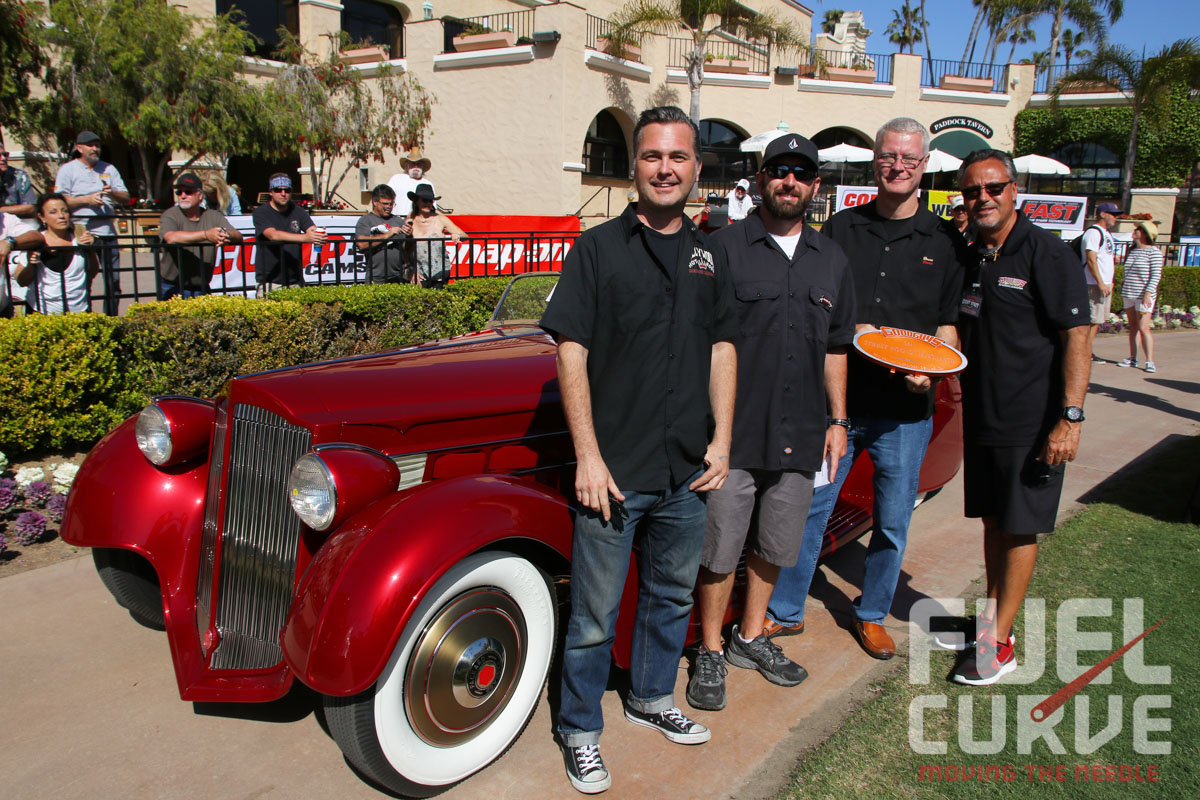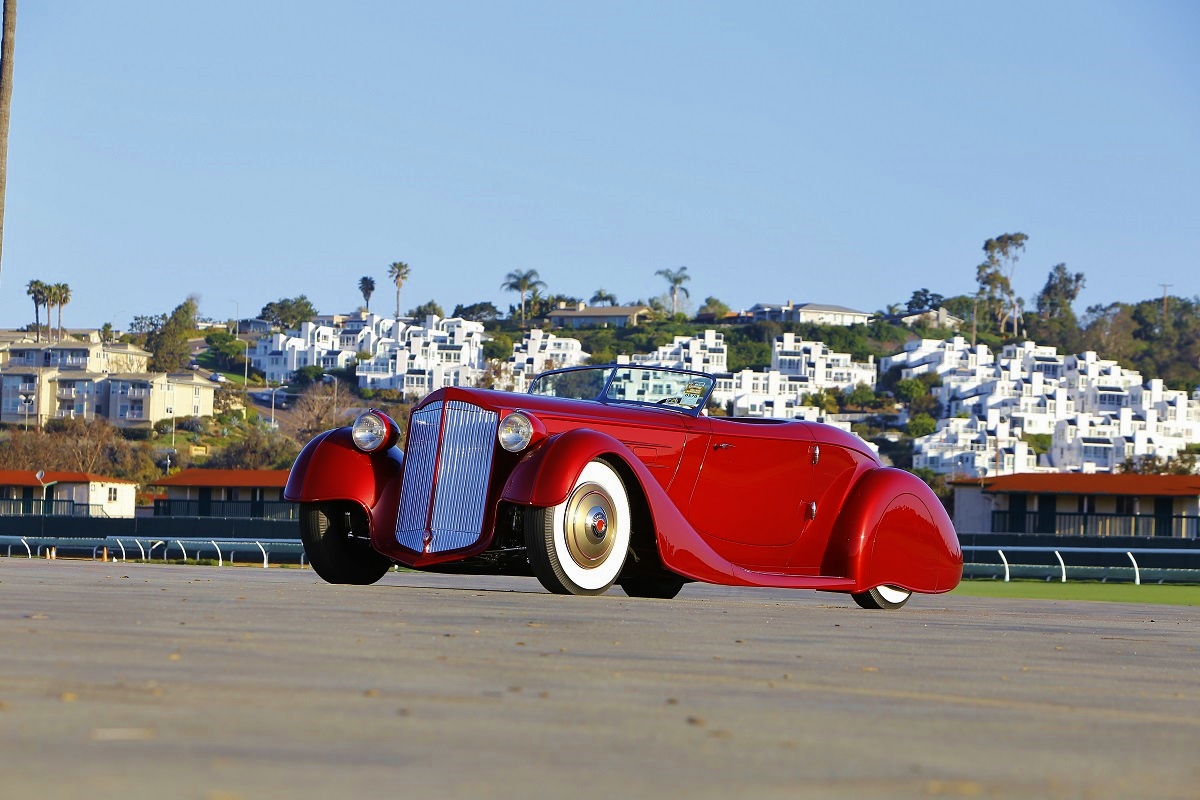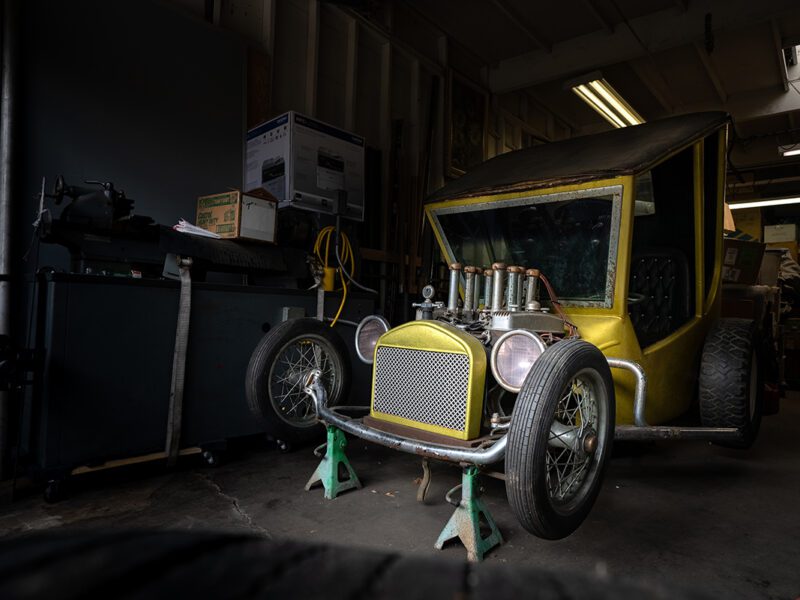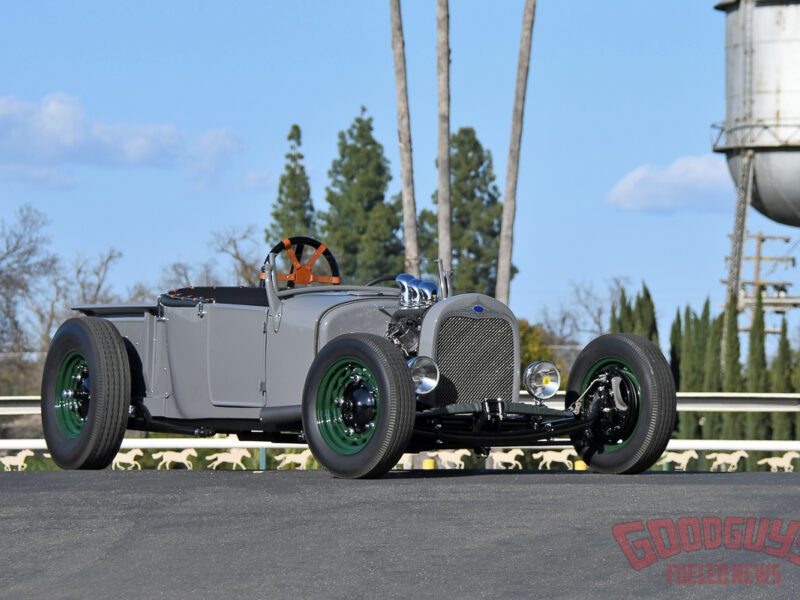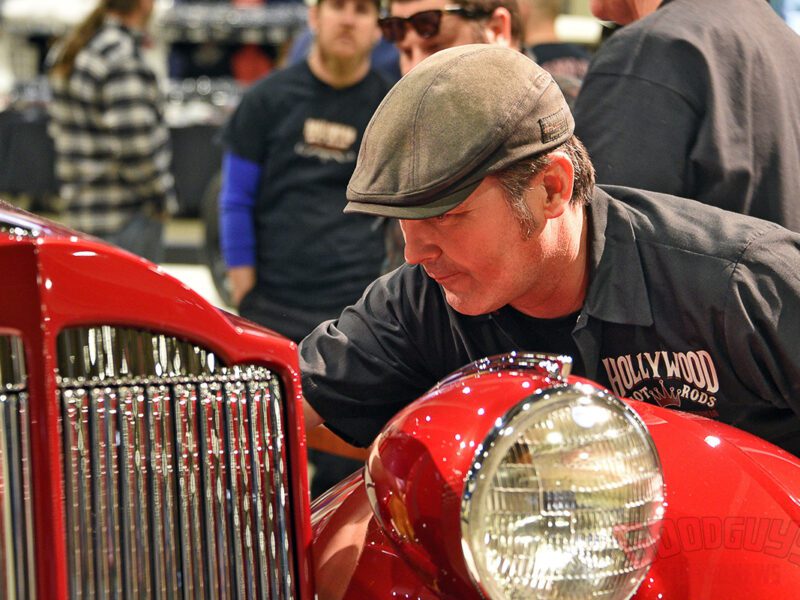Mulholland Speedster – Perfectly Blended
By Brandon Flannery
Photos: Mike Harrington
The Mulholland Speedster is not only a decorated coach built custom automobile, it was a catalyst for new friendships. Bruce Wanta says he and Troy Ladd of Hollywood Hot Rods are kindred spirits. Troy built the Black Widow that Bruce had purchased – a Model T roadster pickup show car that had been issued first as a model car – and the builder and owner quickly became good friends.
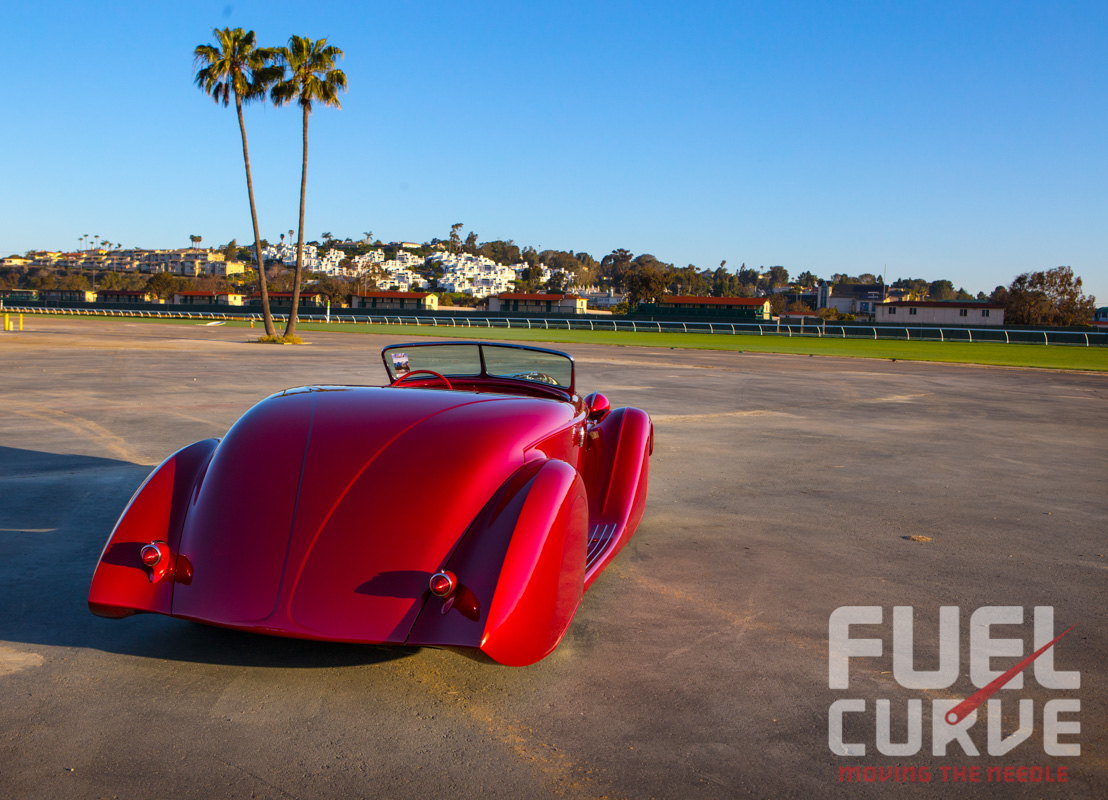
As they walked the aisles of Blackie Gegeian’s last Fresno Autorama in 2010, Bruce was inspired by the Art Deco essence of a late ’30s Ford and told Troy he wanted to build one like that. Bruce added that he wanted to do one around a Packard grille, a design he thought was the ‘prettiest grille ever put on a car.’
After more conversation, Bruce decided he would want the top to come off so he could compete for the America’s Most Beautiful Roadster award. Troy said he had built cars to compete for a couple of times and that Bruce would have to be all in if he was serious. “I thought about it for about half a second and shook his hand,” says Bruce. “We were going all the way.”
[foogallery id=”15426″]
Eric Black was called upon for concept designs. His sketches are done to scale and translate well when built. Bruce says he was flipping through his Hemmings magazine on a plane to Troy’s when he spotted a side profile image of a fully-restored 1936 Packard 1401C. “Well, there’s my perfect car,” he thought. However, a museum piece was no place to start a hot rod project. He turned the page, and the very next ad was for another 1401C, only this one was a “bucket of bolts” and in need of a total restoration.
“I showed the photos to Troy and after talking with Eric, we all agreed it had the right shape,” he says. “I called and struck a deal right there in Troy’s shop and had the money wired the next day.”
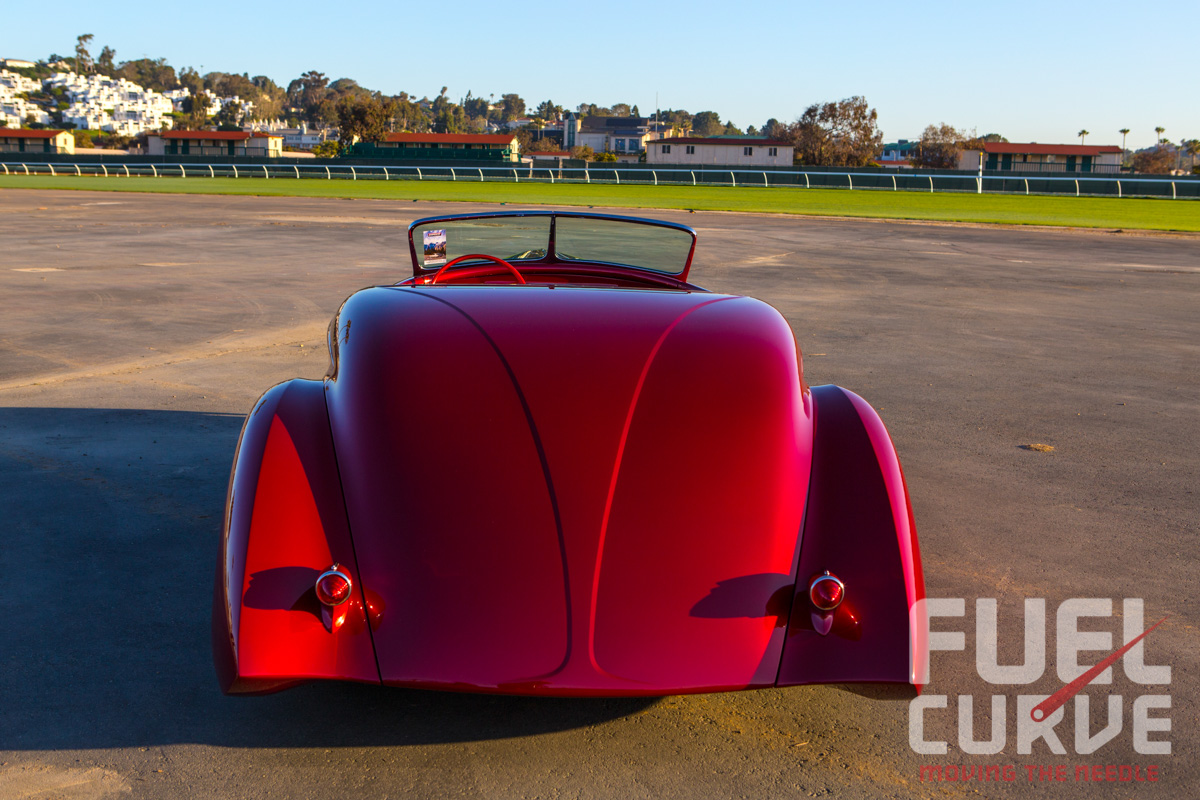
With the car shipping in from Chicago, Troy began laying out a one-off frame with an integral figure eight, or infinity symbol, in lieu of an X-frame. The goal was to keep it period appearing, yet modern at the same time. The rails were even done in C-channel and left unboxed.
The design called for quarter-elliptical suspension fore and aft. A quick-change IRS was re-configured with inboard drum brakes and one-off link bars made to look like vintage cast parts. All the shackles were also handmade to look like old cast parts and many of the moving parts were leather-wrapped in the fashion of the era’s coach built cars.
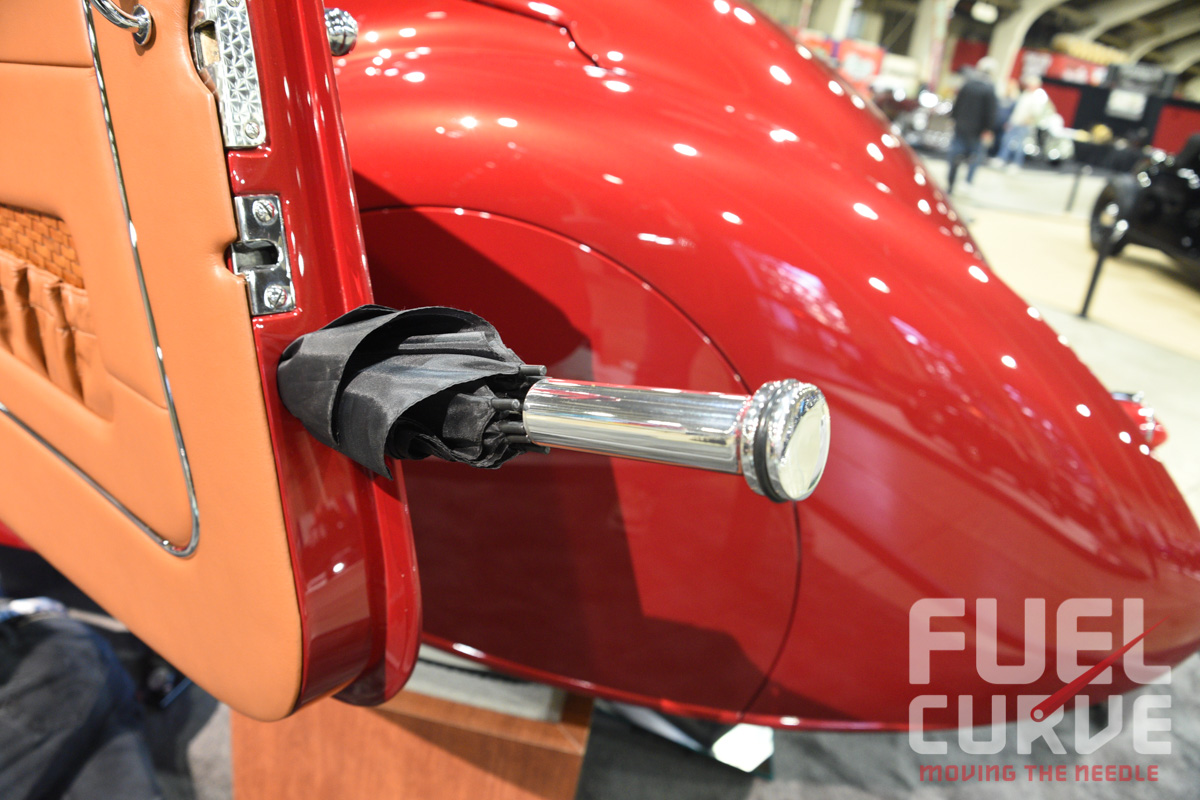
It should be noted that Bruce is a mechanical engineer by trade, and his company creates automated industrial controls. Inspired by a 1930s double-axle farm truck with centrally-pivoted leaf springs, he devised a way to articulate his quarter-elliptical suspension using a pivoting arm and hidden electrical actuators. The Packard can be raised or lowered at the touch of a button without any visual clues. A set of whitewalls and one-off hubcaps put the chassis on the tarmac in style. Inner wheel covers were made for the rear wheels since the brakes are inboard by the axle.
A 1401C Packard is a big car with a big straight-eight engine. Many hours of metal fabrication were required to dial it down to match the concept art. The hood, doors, and rear of the Mulholland Speedster were shortened and the grille was laid back a few inches for a sleeker profile.
[foogallery id=”15428″]
The factory running boards were redesigned to blend gracefully into the fenders. Bruce says each front fender was sliced and diced and consists of 17 individual pieces of new and original metal to get the shapes and scale they were after.
The wooden cab and door frames were eliminated, though the outer skins and beltline were retained when possible. The factory windshield was replaced with a heavily-massaged DuVall screen and the door tops were blended over into the interior. Bruce worked out the logistics of the top, which disappears when not in use, on a plane flight back home to Washington.

“The entire rear portion of the car flips up and the hard top rotates underneath,” says Bruce. “It’s a combination of automatic hydraulic and linear actions that I designed and programmed the electronic controls for. It can be retracted by a switch or remote key fob.”
Bruce also automated the side vents in the hood and the blades of the grille. They retained the car’s beautiful door hinges and swapped the handles for the identical, yet smaller pair from the hood. “Proportionally they worked very well,” says Bruce. “The factory ones were much larger.”
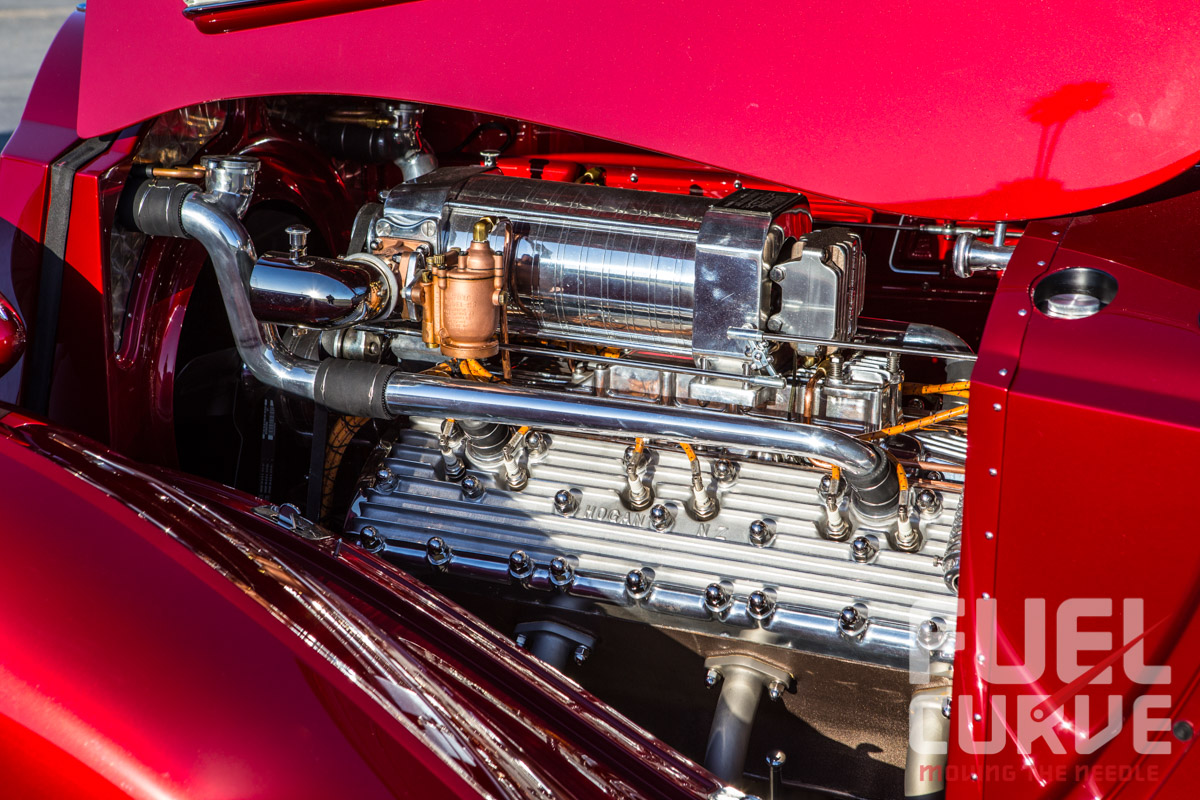
Seeing a dark red Packard at a Concours event locked the color palette down, though it would take painter Mick Jenkins a while to narrow it to two samples. “Mick painted two stainless steel mixing bowls for me and I carried them around for two weeks, holding them up to other reds in parking lots,” says Bruce with a laugh. “In the end, our choice was named Mulholland Merlot and the formula will remain a secret forever.”
Mark Lopez paired the stunning hue with a nice toffee leather upholstery material, accented with a regal bit of basket weaving for the inserts. The stock dash was cleaned up, with the controls moved to the glovebox, and the original gauges were refurbished. Eric Black made several steering wheel sketches, blending elements together until they all agreed on a design, which was then cast in red Lucite and topped with a custom Mulholland V-12 center cap.
Which brings us to the engine. With a car of this caliber, a simple small-block was out of the question, and the factory Packard choices were deemed “not hot roddy enough.” The solution? A Lincoln Zephyr V-12 with finned Hogan heads sourced from New Zealand. The heads also came with a three-two barrel intake that they modified to accept a Latham supercharger. The supercharger was mated to the front pair of carb openings, while the rear was re-designed to be the pop-off valve. A pair of very rare Winfield DD carbs were converted to side draft and mounted on either side. Moderate use of paint and plating detail, along with engine-turned firewall panels fill the engine bay perfectly.

The car’s name was another aspect that eluded the team for some time, until a visitor to the shop came up with Mulholland Speedster, suggesting Hollywood, movie stars and the right era. The car looks like something Clark Gable would drive – a car that would’ve been driven on Mulholland Drive. With that, the Mulholland Speedster was born.
Bruce says the best part of the Mulholland Speedster is the friendship and relationships they all shared over its construction. The team gelled over the many hours of phone calls, conversations, solutions, and inspirations. “It was a heck of a lot of fun,” he says. “And after all, they are cars. If it’s not fun, then what’s the point?”
The team realized its goal of winning that AMBR at the 2017 Grand National Roadster Show. The Mulholland Speedster also captured the World’s Most Beautiful Custom, Custom de’Elegance and the Sam Barris Memorial Award before earning its Goodguys Street Rod d’Elegance honors in Del Mar. Bruce says the car has been doing very well, but the best is yet to come.
“My favorite question was from a show judge at the Chicago World of Wheels. He called me over and told me he thought knew the answer but wanted to hear it from me,” says Bruce. “He asked me why there was bedliner on the inner fenders, and I told him because as soon as it’s done on the show circuit I am driving it. I can’t wait to take it to my local cars-and-coffee event in Seattle and just drive it around.”
An old-style, high-tech, low-tech elegant hot rod that’s stunning enough to win the top awards and destined to be driven and enjoyed? The Mulholland Speedster truly is perfectly blended.
